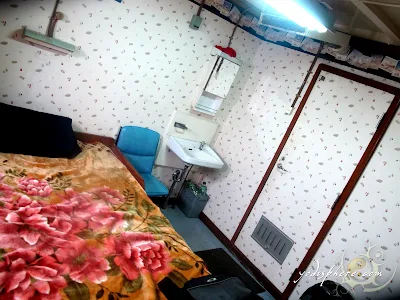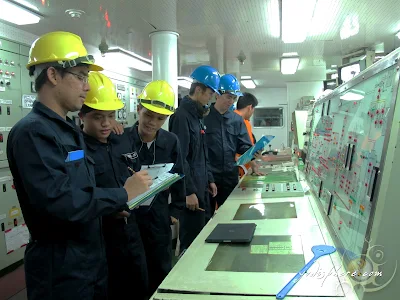A Quick Glimpse of the Life at Sea
I am not a seaman, but I work with them. I talk to them almost everyday, deal with their stories, read about their challenges. You can easily spot some of them - with their dangling large gold necklaces with anchor pendant, bracelets and rings with seafaring-inspired engravings. You know the common joke – “mukha ng may hepa sa dami ng alahas” Some are more discreet, but you can still see the signs on their houses. They usually have iron-work anchor designs at their gates, old gallon and sailboat miniatures as living room decor pieces.
With the sacrifices they’ve been through, they have all the reasons to be proud.
However, some of them are not lucky enough. At the other side of those success stories are really unfortunate saga. I have a friend who jumped ship in Taiwan port, but was repatriated back to the Philippines. Somebody drugged him while on shore leave – was his initial alibi. However, he confided to me, over bottles of beer, that he intentionally quit because he felt he is losing his sanity if he stayed onboard. He said he was so traumatized by the routine that he got chills whenever he sees even just a picture of a sea. I also know a story of a Chief Cook who decided to commit suicide by jumping overboard, was rescued and later diagnosed with psychosis.
Well, it's not a hidden fact that there are number of recorded cases of seafarers losing their sanity while onboard.
All these stories are enough reasons for me to totally wonder what it's like to be onboard a ship. Hence, when I was asked if I want to join the one-week onboard familiarization program for non-technical shipping personnel, I immediately registered and said why not.
The purpose of the program is to familiarize non-seafarer ship manning personnel with bits of technical seafaring stuff onboard Training Ship Kapitan Felix Oca (T/S KFO). But for me, I’m after the experience – the routine, how they survive each day, how they entertain themselves, etc. Of course, knowing some technical stuff is also a plus – considering my line of work.
DAY 1, September 17, 2012, Monday
With the sacrifices they’ve been through, they have all the reasons to be proud.
However, some of them are not lucky enough. At the other side of those success stories are really unfortunate saga. I have a friend who jumped ship in Taiwan port, but was repatriated back to the Philippines. Somebody drugged him while on shore leave – was his initial alibi. However, he confided to me, over bottles of beer, that he intentionally quit because he felt he is losing his sanity if he stayed onboard. He said he was so traumatized by the routine that he got chills whenever he sees even just a picture of a sea. I also know a story of a Chief Cook who decided to commit suicide by jumping overboard, was rescued and later diagnosed with psychosis.
Well, it's not a hidden fact that there are number of recorded cases of seafarers losing their sanity while onboard.
All these stories are enough reasons for me to totally wonder what it's like to be onboard a ship. Hence, when I was asked if I want to join the one-week onboard familiarization program for non-technical shipping personnel, I immediately registered and said why not.
The purpose of the program is to familiarize non-seafarer ship manning personnel with bits of technical seafaring stuff onboard Training Ship Kapitan Felix Oca (T/S KFO). But for me, I’m after the experience – the routine, how they survive each day, how they entertain themselves, etc. Of course, knowing some technical stuff is also a plus – considering my line of work.
DAY 1, September 17, 2012, Monday
Welcome aboard!
 |
| Calm scene of T/S KFO as we approached it riding a life boat from Manila South Harbor |
If I may borrow an expression from Goethe, I guess all I need to do is enjoy the experience when I can and endure when I must.
We are supposed to leave at 9:00 am from Pier 15 Manila South Harbor going to Palawan but there's some unfortunate accident happened on one of the cadets who slipped on the shower room and cut his head. How’s that for welcoming news!
 |
| Picturesque Manila skyline taken from Manila Bay onboard T/S KFO |
 |
| Let me call this our Armageddon shot |
I called our first activity the getting to know your floating country.
“A ship is like an autonomous country” – I heard this expression few times while onboard T/S KFO – mentioned by the two cadets who showed us around and from a training officer onboard, which I agree.
 |
| Training Ship Kapitan Felix Oca (T/S KFO) |
 |
| Cadet trainees having their dinner at the mess hall |
 |
| Deck lecture room with seating capacity of 182 person |
 |
| Quick safety briefing and ship familiarization |
 |
| Safety briefing and equipment familiarization at the bridge |
 |
| Quick familiarization tour of the TS KFO engine room |
 |
| The cabin room where I stayed for a week |
I tried catching a quick nap but hey, my whole room is swaying and sleeping is weird!
Dinner is served at 5:00 pm, yes it’s not snack it’s dinner – we are still in the Philippines but it’s like we are in a different time zone.
After snack, err dinner, we prepared for our evening duty set at 8:00 pm to 12:00 am.
Into the dark room
 |
| Me trying hard to understand ship calculations and equipment readings |
Our time on the bridge is spent watching for other ship and vessel traffic using radar and binoculars. The extra crewmember on the bridge at night is there to help look for other vessel traffic or perhaps to make sure the watch officer doesn’t fall asleep.
 |
| Ship officers and cadets plotting ship course |
We are fortunate to have a clear sky that night and I chance a few cadets who seemed stargazing outside. I approached and ask them what they are doing and they said it’s a celestial navigation activity – uh celestial… what? “Ok just go on with the activity,” I just said. I later found out that celestial navigation is an old navigation technique using stars – awesome!
Oh and their description of ocean waves is interesting - from calm to rough to phenomenal - yes, deadly waves is called “phenomenal.” In that case, I guess I can describe seafaring as phenomenal.
DAY 2 - September 18, 2012 – Tuesday
Still sailing
Got a rough first night - I felt like there's always somebody knocking at my cabin door - and for some bad luck, my left headset was broken so I'm hearing Enya on my right and the constant knocking and creaking on my left, luckily out of exhaustion I was able to sleep for four hours.
 |
| Regular morning calisthenics at the poof deck |
 |
| Tae Bo lesson courtesy of me and Bern |
 |
| Sweating it out while admiring the scene |
We had a quick breakfast then head on to the bridge for our 8:00 am to 12:00 pm bridge duty. Weather is fine and everything seems in order at the bridge, but I was secretly praying for a rough weather though, to experience some bridge action.
 |
| Cadets having a life-jacket donning briefing as part of the Fire Drill |
 |
| Life Boat Drill! Off to your muster station! |
 |
| Me trying to understand the charts |
 |
| Awesome dolphins playing with us |
We arrived at Puerto Princesa, Palawan around 4:00 p.m and decided to take a short shore leave. We spend the night at the city to prepare for our by-chance and impromptu Underground River escapade.
The best part of this trip is, we successfully made it to the world famous Underground River!
DAY 3 – September 19, 2012 – Wednesday
At the heart of the ship
We returned to the ship around 4:30 in the afternoon exhausted from our whirlwind underground river tour. But even though we are tired, we still made it to our 8:00 pm duty at the heart of the ship – the hot and noisy engine room.
This time we are required to wear our cover-alls for safety. As we entered the engine room door, we were greeted by a blast of hot air and a surprisingly loud noise that characterizes the engineering spaces.
 |
| Me and Bern taking hourly equipment readings as part of our watch duty |
 |
| Me talking to cadets at the Engine Control Room |
 |
| MEMORUNDUM? Notice posted at the ECR |
We spent the next hour or so exploring the engine room and came back at the ECR soaking in sweat. I later catch a nasty cough and my sinusitis gone wild again so I tried resting early.
DAY 4 – September 20, 2012 – Thursday
It’s a prison
At 6 am, I slid out of bed, bleary-eyed and feeling more tired than when I went to bed. I got a terrible headache so I decided not to attend the morning exercise. After breakfast, I rushed back to my cabin and sought the only relief one can get when one has this condition and that is bed.
This day is an exception to our typical day at sea because today is like our usual lazy Sunday – we can rest. It’s been only few days and I’m sick already and as I lay in my cabin, I spent a lot of time thinking about the whole point of being a seafarer.
Only one conclusion came out – it’s like being on a prison with a whole new way of life.
DAY 5 – September 21, 2012 – Friday
We made it!
 |
| At last we made it!..I mean the jump shot. |
Our last activity before disembarking T/S KFO was to observe anchoring procedures – but there’s not much to see because we are not allowed to be that close to the actual risky operation. We just contented ourselves at the training bridge, camwhoring.
After a few goodbyes with some of the crew and last camera shots, we left T/S KFO ending our one-week adventure.
I respect them more
I got a chance to experience what it's like to be a seaman even for a very short time, one week to be exact. PJMCC, the program sponsor, said it’s a familiarization program for non-technical staff. So basically it’s a technical familiarization which of course will not really become effective because everything onboard is too technical.
However, I personally I assume that the most important outcome of this exercise, for me at least, is the chance to have a deeper understanding of what it means to be a seaman – a comprehension which goes beyond such things as rank, jewelries and seeing the world for free.
Out at sea for months at a time, seafarers are confronted on a nearly daily basis life-threatening danger, isolation, loneliness and exhaustion plus the fact that they always missed important family events back at home. The work of a seaman was hard and is truly a sacrifice.
I know I only had a glimpse of some of the many facets of the vast experiences a life at sea can bring about. However, I guess it’s safe to conclude that life at sea is not for everyone.
There are so many inconveniences that come with this profession, but those who decided to take the plunge are really brave enough - and now, I respect them more.



No comments:
Got Something to Say? Thoughts? Additional Information?